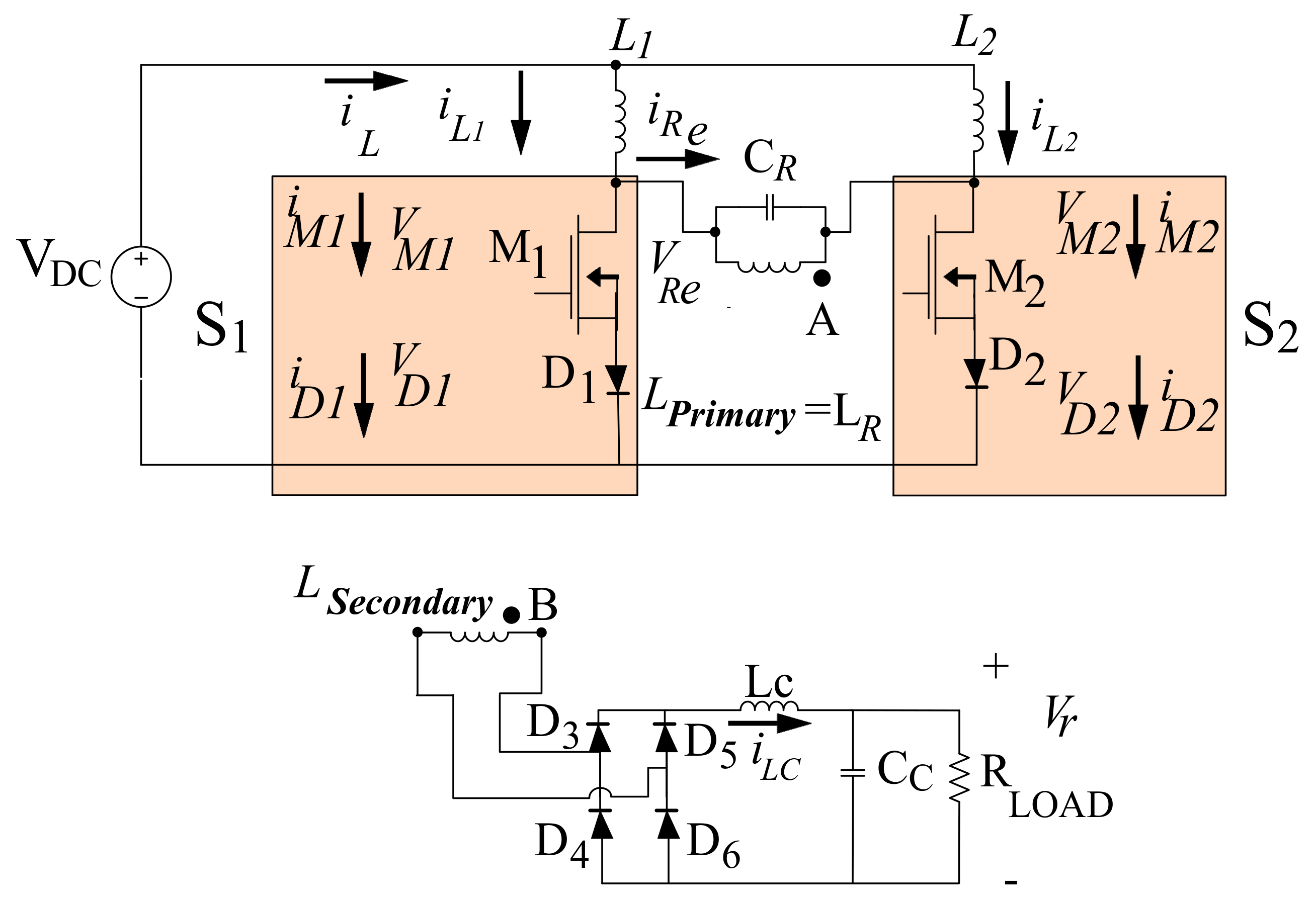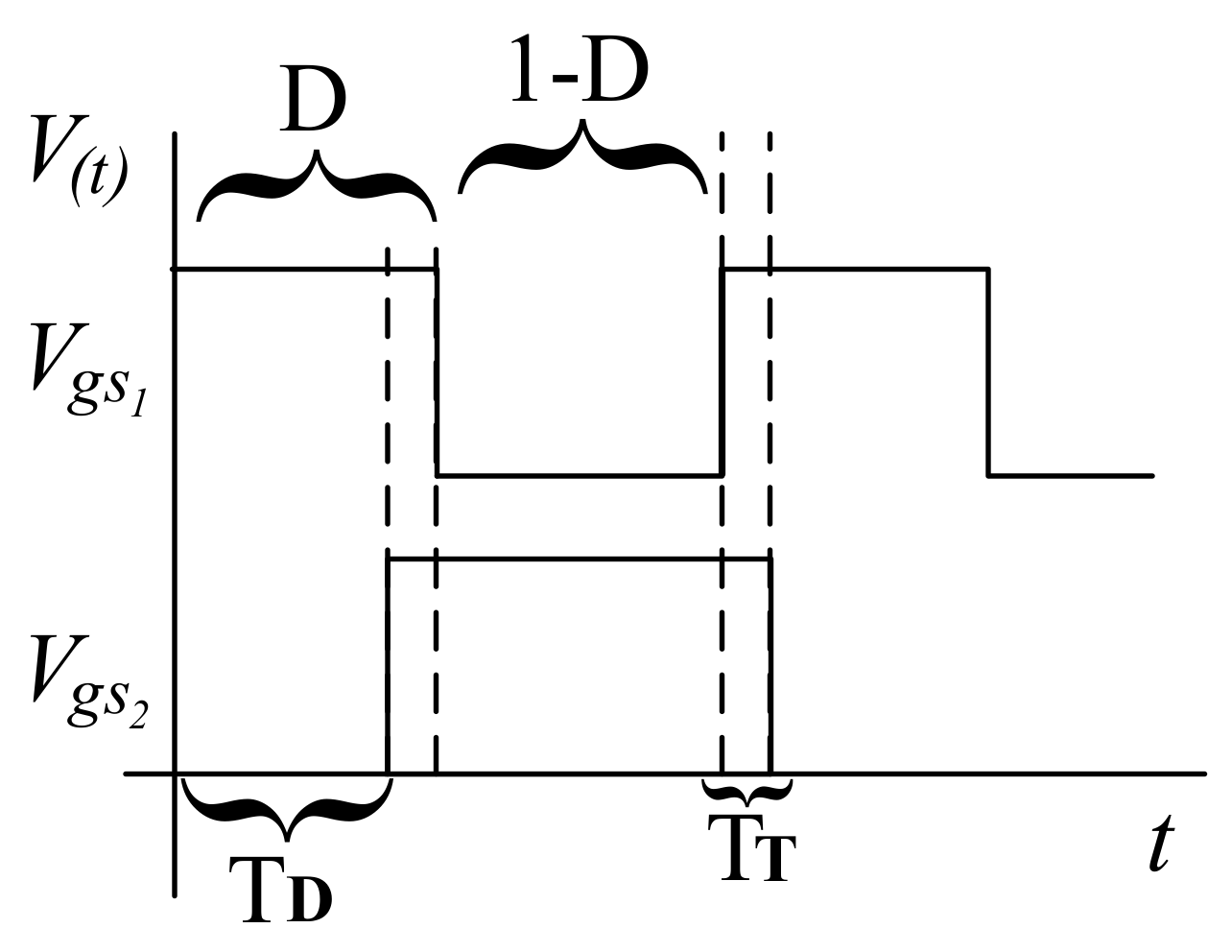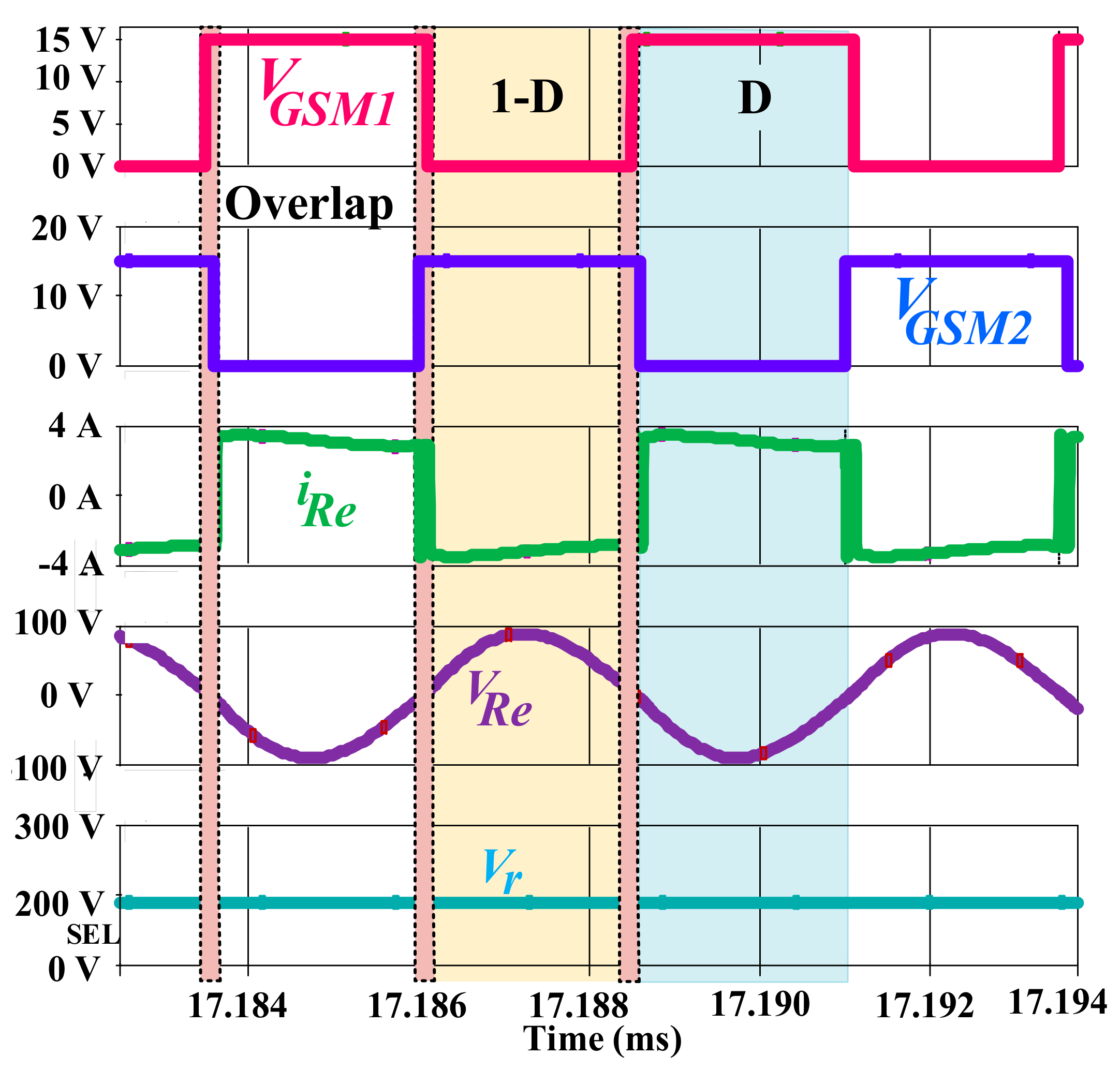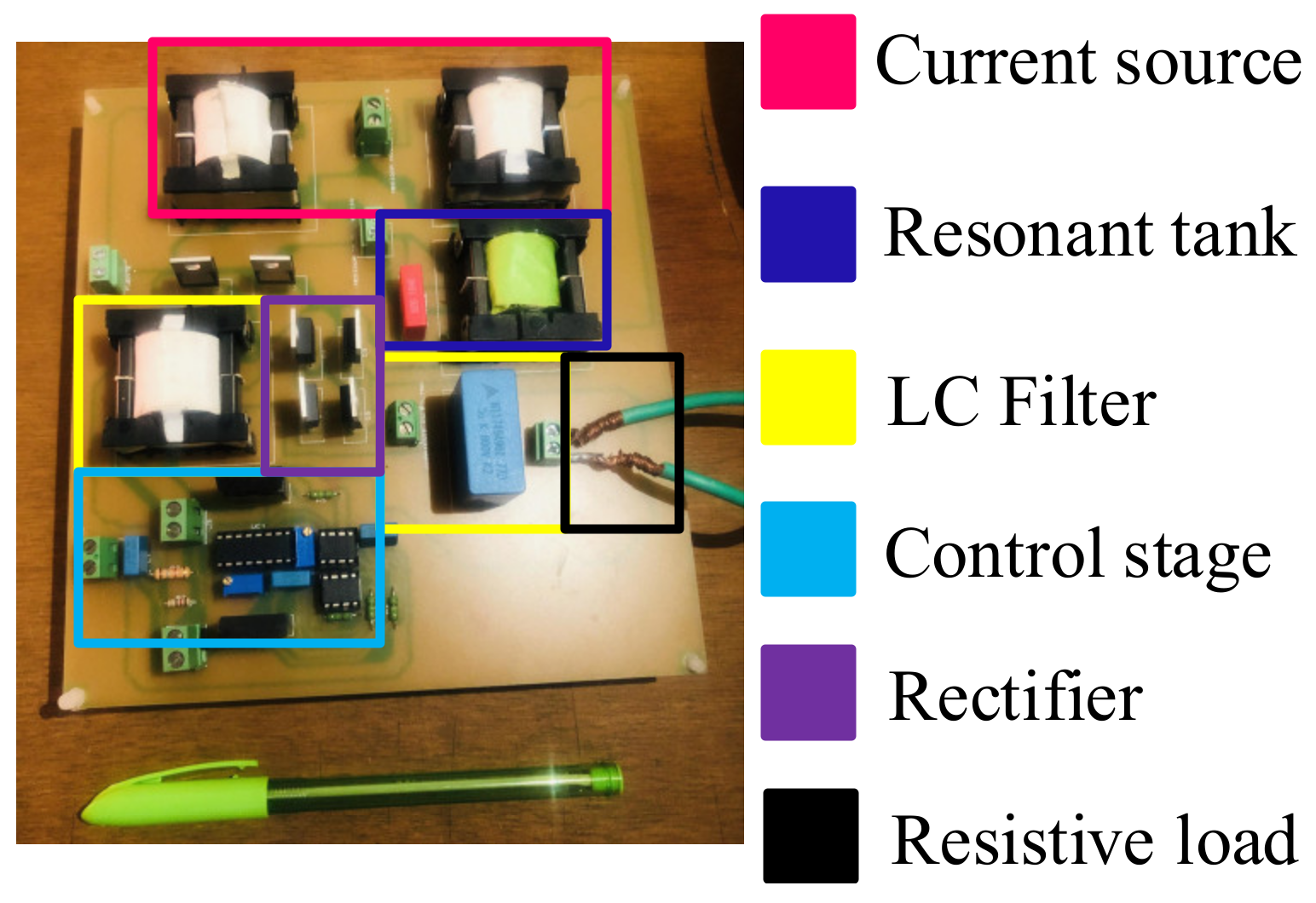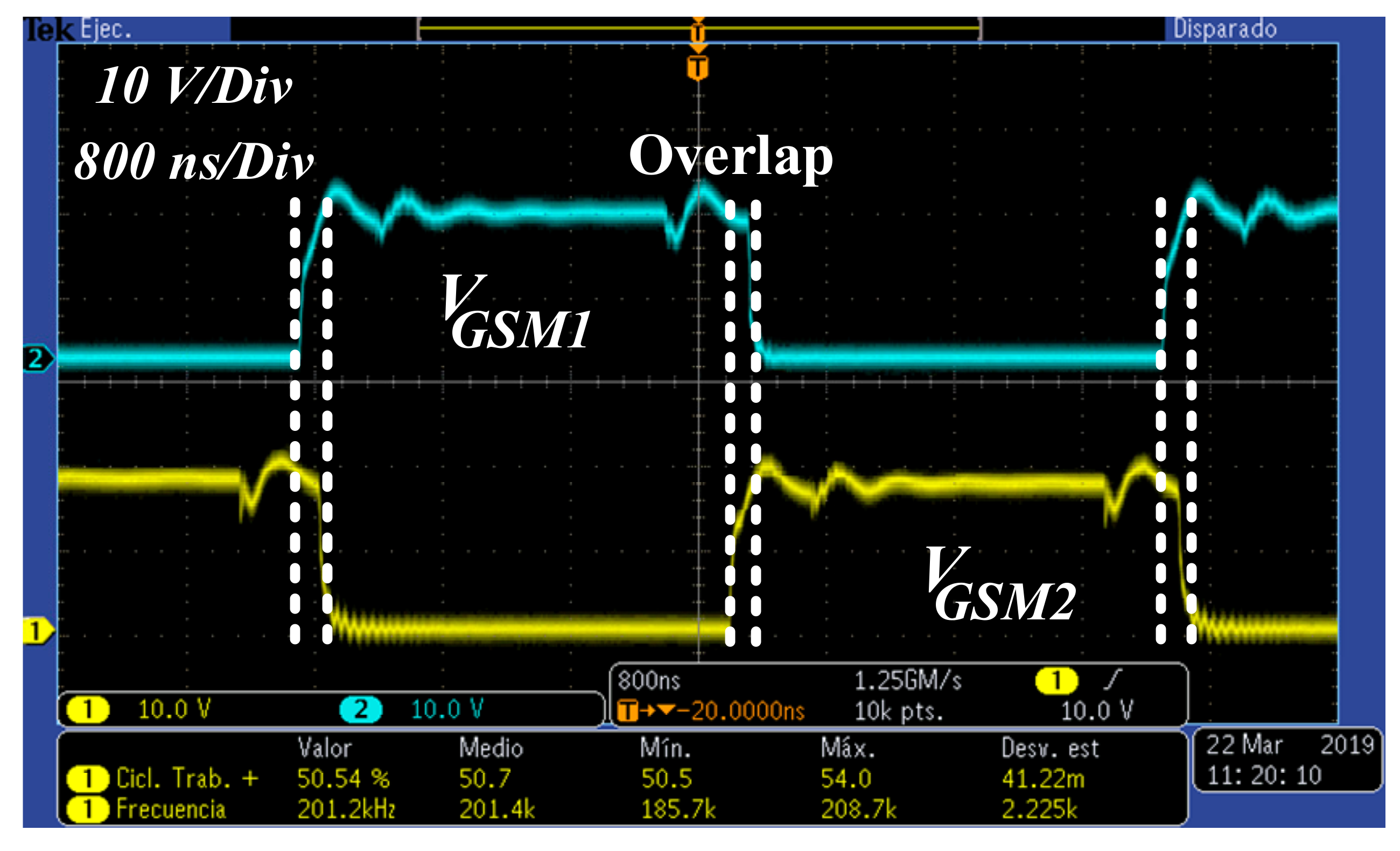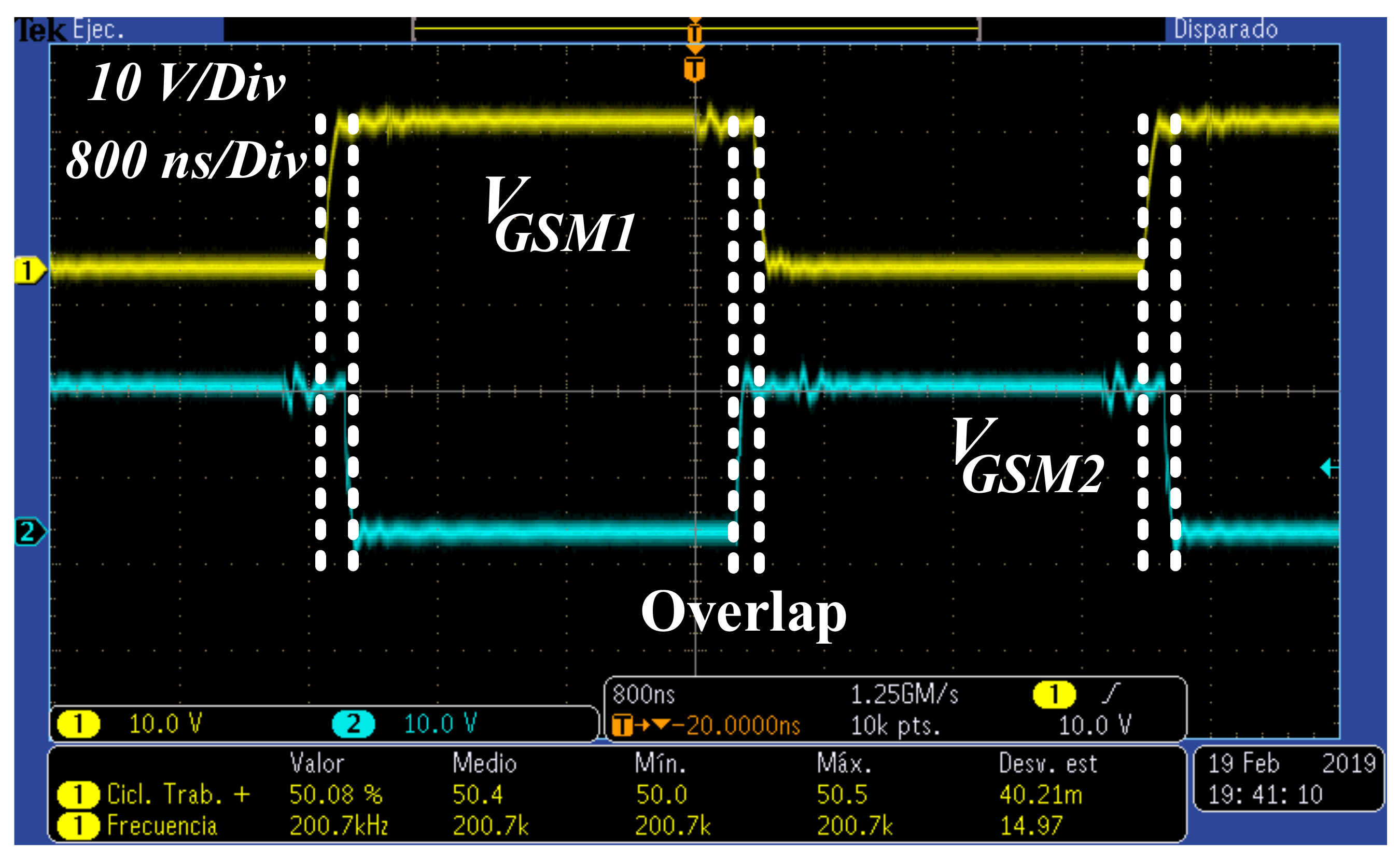The topology shown in
Figure 1 is comprised of four stages: the first stage consists of two current sources (
L1 and
L2) and a DC voltage source (
VDC), the second stage by a parallel resonant tank (
LPrimary and
CR) with magnetic isolation derived by
LPrimary, where
LPrimary is coupled to
LSecondary (from part A to B), the third stage by a full-wave rectifier (
D3–
D6), and the fourth stage by the decoupling elements (
Cc and
Lc). The operation of the circuit is as follows: the two inductors
L1 and
L2 provide the two current sources to the parallel resonant tank, the unidirectional switches
S1 and
S2 short-circuit the current sources periodically in order to feed the parallel resonant tank formed by the transformer (composed by
LPrimary and
LSecondary) and the resonant capacitor
CR with a square current waveform. The parallel resonant tank filters this waveform and applies a sinusoidal voltage waveform to the full-bridge rectifier (
D3, D4, D5 and
D6). The rectified signal is filtered by
LC and
CC and it is applied to the load (
RLOAD). One important characteristic of the CFRC (
Figure 1) is the need to have an overlapped control, because if there is no overlapping control between
M1 and
M2, the inductance (
L1) would be charged by the current
iL1 (t), and the current
iL2 (t) from the second inductance (
L2) would flow directly through the resonant tank. Under the dual condition,
iL1 (t) would flow through the resonant tank and
iL2 (t) through
L2. However, if there is no overlapped control,
iL1 (t) and
iL2 (t) could be canceled, although not completely, producing a considerable increase in the losses on the unidirectional switches. Furthermore, the resonant tank and the components used need to be carefully selected, since these parameters directly affect the overlap signals in
S1 and
S2. Additionally, the high frequency transformer is a critical part of the resonant converter. Its design affects efficiency, weight, and dimension of the whole topology. This fact is important to improve the efficiency of the topology. Considering these statements, a brief comparison of different semiconductor devices should be performed. As a result of the advancement in the field of power semiconductor technologies [
37,
38,
39], SiC MOSFETs, SiC junction gate field-effect transistors (JFETs), SiC Schottky barrier diodes, and gallium nitride (GaN) transistors provide a valuable opportunity to obtain high efficient performance with compact size. Part of the primary characteristics in all power semiconductor devices are related to the operating at high power, high frequency, and high temperature. In fact, many works have been reported in the literature analyzing the physical breakdown mechanisms, modeling, characterizations, and the trade-off characteristics between the breakdown voltage and the on-resistance of Si, SiC, and GaN-based power semiconductor devices [
40,
41,
42,
43]. As a result of these studies, some characteristics are shown in
Table 1.
Overlap in Gate-Signals of M1 and M2
To determine the effect of the overlap, an initial simulation study is developed under the following considerations: (1) time delay proposed between the turn on of
M1 and
M2 is 0.49, this value was taken because
TD must be as close as 0.5, with the aim of not having such a long overlap; (2) a quality factor of the resonant tank is sufficiently high to filter all the current harmonics, except the fundamental; (3) all inductors and capacitors are lossless; (4)
D3, D4, D5, and
D6 are ideal diodes; and (5) unidirectional switches were performed by SiC diodes (C4D08120) and SiC MOSFETs (C2M0160120D), because of their improvements for AC-DC and DC-DC converters. These devices can operate with reduced conduction and switching losses over higher frequencies, and higher temperatures minimize the requirements for the passive components and reduce cooling demands [
47,
48,
49]; however, the performance given by SiC power devices will be compared with Si and GaN. The switching frequency (
Fsw) was considered to be 200 kHz. The simulation results in
Figure 2 created in PSpice
® show the key waveforms of
S1 (
Figure 2a),
S2 (
Figure 2b),
D1 (
Figure 2c), gate-signals in
M2 (
Figure 2d), and
M1 (
Figure 2e). These simulation results are also based on the design parameters and design methodology shown in
Table 2 and
Table 3.
From
Figure 2, when the overlap begins (gate-signal in
M1 and gate-signal in
M2 are in the on-state)
, the current
iS1 decreases to zero, and the current
iS2 increases. This behavior is related to the charge and discharge of the internal stray capacitances of
D1 and
D2.
In this sense, when
S2 is in the on-state,
M2 can be modeled by its output parasitic capacitance in parallel with its parasitic resistance, and
D2 as a parallel made up of the same diode and its stray capacitance. Furthermore,
Figure 3 shows the hard switching in
D1 and
M1 caused by the effect given by the overlap. In this manner, to determine the converter performance effects, based on
Figure 3, three modes are proposed considering the current and voltage waveforms of
S1 and
S2; therefore, the first mode (MODE A from
t0 to
t2) performs a fall-rise of
is1 and a rise-fall of
is2, the second mode (MODE B from
t2 to
t3) represents the time when
is1 keeps its value and
is2 is zero, and the third mode (MODE C from
t3 to
t4) represents the dual condition of MODE B.
From
Figure 3 and based on times
t0 to
t4, the equivalent circuits are obtained, as shown in
Figure 4. In these circuits, an equivalent resistance (
Requ) was considered as the load in the resonant tank, where
Requ represents the
RLOAD seen from
Lr. Then, based on the operation, MODES are shown during the overlap and equivalent circuits in
Figure 3 and
Figure 4, respectively. The modes A, B, and C are detailed below:
Time
t0-t1 (
Figure 4a): this time starts when the gate-signal in
M2 is in the on-state, thereby the overlap starts. During this time,
iS1 decreases to zero (and remains at 0 A) and
iS2 increases its value the same as the input current (
IL). Moreover, since
S2 is in the on-state, the diode
D1 can be modeled as a parallel by the same diode and its stray capacitance
CD1, and
M1 by a drain-source resistance
RDSON M1. In this moment, the voltage of the stray capacitance in
D1 (
VCD1) can be represented as shown in Equation (1).
where
VRES is the voltage of the resonant tank,
VDSM1 represents the voltage drain-source in
M1,
VDSM2 the voltage drain-source in
M2, and
VD2 the forward voltage in
D2. Furthermore, in this time, there is a “charge” condition in
CD1 which generates an increase of switching losses in
S1 until the voltage in
D1 reaches its forward voltage.
Time
t1–
t2: It represents the instant when
iS1 increases and
iS2 decreases its value, turning on
S1, and modeled
D2 as a parallel by
D2 and its stray capacitance
CD2, and
M2 by a drain-source resistance
RDSON M2 (
Figure 4b). In this time, the voltage of the stray capacitance in
D2 (
VCD2) can be represented as shown in Equation (2), where
VD1 represents the forward voltage in
D1.
Time
t2–
t3: In MODE B (
Figure 4c),
M1 and
M2 are in the on-state. Furthermore,
is1 stays constant and
is2 stays at 0A, modeling
D2 and
M2 the same as from
t1 to
t2. On the other hand, there is no current in
S2 but there is a voltage in
D2, increasing the power losses. Moreover, the voltage of the stray capacitance in
D2 (
VCD2) can be represented the same as Equation (2).
Time
t3–
t4: MODE C starts (
Figure 4d), the gate-signal in
M1 is in the off-state, and thus the overlap is finished. Furthermore,
M2 is in the on-state and
is2 is increasing. During this time,
S1 is in the off-state after finishing the discharging process, which causes the stored energy to be lost not only in
M2 but also in
D2. Additionally, as a result of
M1 in the off-state,
VRES will be split in
D1 and
M1 with a complementary voltage in
D2. In fact,
VCD2 can be modeled as shown in Equation (3).
From
Figure 3 and
Figure 4, the behavior given by the recovery time in
D1 and
D2 during their shutdown states causes
D1 and
D2 to be in the on-state even when
M1 and
M2 are in the off-state, which indicates that if the complete switch is analyzed, the MOSFET and diode do not share the same shutdown time. Furthermore, in MODE A,
iS2 increases, and the stray capacitance in
D1 is discharging, causing
iS1 to decrease to zero, then, the current
iS1 increases its value because the current
iS2 decreases. This current will be zero, until the voltage in
D2 is zero again.
In this sense, when the voltage in
D2 is zero, the current
iS2 will increase, therefore, this is the main reason to generate hard switching in the complete switch. On the other hand, the power losses achieved in the simulation by
S1 plus
S2 are 31 W with a global efficiency of 62% and a time delay between gate-signals of 0.49. It is important to estimate the applied overlap. Therefore,
Figure 5 shows the overlap to consider in the analysis.
From
Figure 5,
D is the applied duty cycle, the time delay between the gate-signals of
M1 and
M2 (
VGSM1 and
VGSM2), and represents the overlap time when
M1 and
M2 are in the on-state. As mentioned,
TT is defined in Equation (4) and
TD is defined in Equation (5).
Replacing (4) into (5) and considering that the energy transferred to the load depends on the duty cycle, the selected duty cycle of the resonant tank is 0.5.
To assess the combination of power semiconductor devices in the unidirectional switch and to verify Equation (7) based on the parameters and design methodology described above, three different converters are designed combining Si-MOSFET and diode (first array), SiC-MOFET and diode (second array), and GaN-transistor SiC-diode (third array). The power devices are selected based on the stress level calculations as well as the similarity in the electrical ratings between the Si and SiC devices (as a result of the reduced drain to source voltage in the GaN-transistor), parasitic capacitances, current rating, switching speed, on-resistance, maximum junction temperature, and following the primary comparison between the characteristics of every device [
50,
51], mainly focused in the work presented in [
52]. Therefore,
Table 4 shows the specifications of each power device used in the design.
Figure 6 shows the efficiency versus variations in
TD performed by different power semiconductor devices obtained in the simulation.
According to
Figure 6 and considering
TD = 0.5, a global efficiency and total power losses (switching plus conduction) in
S1 plus
S2 of 86% and 27 W were performed by the Si-MOSFET and Si-diode combination. Furthermore, SiC-MOSFET plus SiC-diode performed an efficiency and power losses in
S1 plus
S2 of 92.7% and 14 W, respectively. Finally, the performance given by the combination of GaN-transistor plus SiC-diode were similar to the combination of SiC-MOSFET plus SiC-diode with an efficiency of 94% and power losses in
S1 plus
S2 of 11 W.
Moreover, the performance given by the overlap dramatically affects the efficiency of the whole converter, thus, it is suggested to take into account an overlapped control in a CFRC since the problems associated with the discharging of the transistor output the capacitance (
Cout). When the switch voltage increases, the MOSFET (M
1)
Cout is charged via
D1 to the peak value of the switch voltage, and then remains at that voltage until the transistor turns on. At this time, the capacitance
Cout is discharged through the transistor, resulting in switching loss. According to
Figure 6, with
TD estimated to be 0.5, the power losses in
S1 plus
S2 and global efficiency performed by SiC-MOSFET plus SiC-diode were 14 W and 92.7 %, which performance is reasonably similar in comparison with the combination of GaN-transistor plus SiC-diode. In this way, the complete simulation results achieved from the DC-DC resonant converter performed by SiC-MOSFET plus SiC-diode are presented in
Figure 7.
The key waveforms from the resonant tank in
Figure 7 show the previously calculated overlap of
M1 and
M2. Alternatively, both the input current (
iRe) and voltage (
VRe) at the resonant tank show a condition close to resonance since both signals are in phase. Furthermore, the output voltage (
Vr) is 207 V, which indicates that the parameters proposed in
Table 2 have a relative error of 1.42% between them and the simulation results.
On the other hand, with the aim to compare the performance and conditions given for the topology, a comparison of a non-overlapped (
Figure 8a) and overlapped control (
Figure 8b) was made, focusing its attention on
vS1 and
iS1.
From
Figure 8a, with a non-overlapped control, not only the voltage and current on S1, but also the resonance condition will be dramatically affected, causing negative voltages, as shown in
Figure 8a. This issue would affect the entire efficiency because an overlap control provides a ramp shift signal to the ramp generator in response to a detection signal that indicates activity of the switches in the power stage. The ramp shift signal adjusts the first and second ramp signals relative to each other so as to minimize any gap and any overlap between the first and second ramp signals.
In this way, to have a good relation overlap-efficiency, an important point to consider is to work with an overlapped control to have optimal conditions, as shown in
Figure 8b. Furthermore,
Figure 8b shows less power losses as a result of the less current peaks obtained in comparison with the non-overlapped behavior presented in
Figure 8a.
